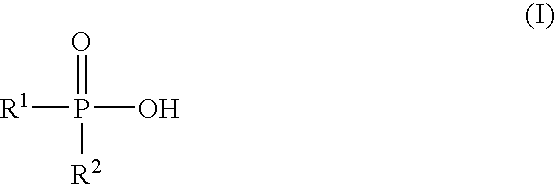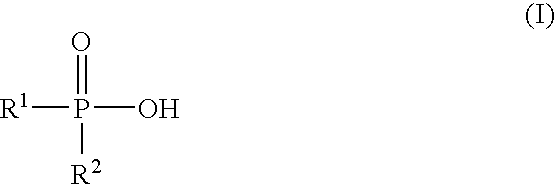Process for the preparation of highly purified, dialkyl phosphinic acids
- Summary
- Abstract
- Description
- Claims
- Application Information
AI Technical Summary
Benefits of technology
Problems solved by technology
Method used
Image
Examples
example i
Synthesis
[0043] To synthesize bis(2,4,4-trimethylpentyl)phosphinic acid, a 1.5 liter autoclave was charged with 40 g (0.377 moles) of sodium hypophosphite; 40 g of acetic acid; 132.3 g (0.943 moles) of diisobutylene (80%); and 2.8 g (0.019 moles) of tert-butyl peroxide initiator. The mixture was then heated to about 135° C. during an 8 hour day for about four days, i.e., a total of 30 hours and 1.4 g of the initiator was added at the beginning of each day. The reaction mixture was monitored by 31P NMR and resulted in the composition identified in Table I below. The original mixture contained 75.3% of the desired dialkylphosphinic acid product and 12.1% of the undesired monoalkylphosphinic acid by-product.
Purification
[0044] The completed reaction mixture (220 g) was transferred to an Erlenmeyer flask and heated in the range of from about 70° C. to about 80° C. to reduce the viscosity. 38 g of water was slowly added until two phases were observed. The aqueous phase was removed and ...
PUM
 Login to View More
Login to View More Abstract
Description
Claims
Application Information
 Login to View More
Login to View More - R&D
- Intellectual Property
- Life Sciences
- Materials
- Tech Scout
- Unparalleled Data Quality
- Higher Quality Content
- 60% Fewer Hallucinations
Browse by: Latest US Patents, China's latest patents, Technical Efficacy Thesaurus, Application Domain, Technology Topic, Popular Technical Reports.
© 2025 PatSnap. All rights reserved.Legal|Privacy policy|Modern Slavery Act Transparency Statement|Sitemap|About US| Contact US: help@patsnap.com



